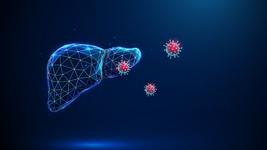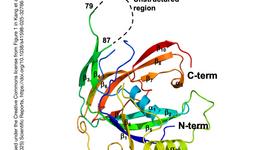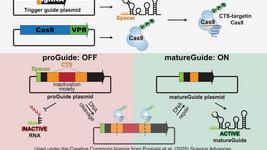CMN Weekly (2 May 2025) - Your Weekly CRISPR Medicine News
By: Gorm Palmgren - May. 2, 2025
Top picks
- A new study presents a powerful new AI-based method for identifying Cas1 proteins – key markers of CRISPR systems – using Simplified Molecular Input Line Entry System (SMILES) encoding and graph neural networks. The approach outperforms existing tools in detecting Cas1 proteins, particularly in bacterial datasets, and could accelerate the discovery of novel CRISPR-Cas systems. While focused on Cas1, the method shows promise for broader applications to other Cas proteins, potentially expanding the CRISPR toolkit for therapeutic use. Its integration of deep learning and molecular graph representation marks a significant advance in computational CRISPR research.
- YolTech Therapeutics' CRISPR-based base editing therapy YOLT-101, using a novel adenine base editor (hpABE5), has achieved dose-dependent, durable LDL-C reduction in heterozygous familial hypercholesterolemia (HeFH) patients via a single IV dose. By precisely disrupting PCSK9 in hepatocytes without DNA breaks, the 0.6 mg/kg cohort showed ~50% LDL-C and >70% PCSK9 reduction with no serious adverse events. These early results support YOLT-101 as a potential one-time treatment for lifelong lipid control.
Research
- CRISPR has been used to introduce the DNMT3A R878H mutation into mice, modelling the human R882H hotspot. Mutant haematopoietic stem cells displayed reduced DNA methylation, impaired p53-PUMA signalling, and enhanced self-renewal following γ-radiation. These transcriptomic changes confer a competitive advantage and increased lymphoma susceptibility, highlighting how DNMT3A mutations predispose HSPCs to malignancy under genotoxic stress.
- Using CRISPR-Cas9, researchers engineered over 1,000 novel PAM-specific enzymes and trained a neural network, PAMmla, to predict PAM recognition across 64 million variants. Custom enzymes precisely edited the P23H allele in the rhodopsin gene, causing retinitis pigmentosa, and outperformed PAM-relaxed variants in specificity and efficiency in vitro and in vivo. This machine learning-guided approach offers a safer, target-tailored alternative for therapeutic genome editing.
- In an effort to treat chronic pain, an American study has used patient-derived induced pluripotent stem cells (iPSCs) harbouring the A1632G mutation in SCN9A, encoding Nav1.7, to generate sensory neurons for electrophysiological analysis. Correction of the mutation using CRISPR-Cas9 reverses hyperexcitability, while its introduction into control iPSCs recapitulates the disease phenotype.
- A new study compares CRISPR-Cas9, Cas12f1, and Cas3 systems for eradicating carbapenem resistance genes KPC-2 and IMP-4 in E. coli. All systems achieved 100% gene removal and restored ampicillin sensitivity, with Cas3 demonstrating superior plasmid clearance. Additionally, all three systems effectively blocked horizontal gene transfer. These findings position Cas3 as the most efficient tool for CRISPR-based antimicrobial strategies.
- American researchers present the L2S2 web server that integrates gene expression profiles from 248 cell lines treated with over 33,000 compounds and 7508 CRISPR knockouts, yielding 1.678 million perturbation signatures. Users can identify small molecules or gene knockouts mimicking or reversing input gene sets. L2S2 enables drug repurposing and personalised therapy development by linking gene signatures to disease, tissue, and compound classes.
Industry
- Intima Bioscience has used CRISPR-Cas9 to knock out the intracellular checkpoint gene CISH in neoantigen-reactive TILs, enabling durable tumour regression in a patient with refractory colorectal cancer. The patient achieved an ongoing complete response beyond two years. This first-in-human trial highlights CISH as a promising, non-surface immune target and structurally enables future small molecule checkpoint inhibitors for hard-to-treat solid tumours.
- Ensoma's preclinical data show its CRISPR-Cas toolkit, delivered via VLPs targeting haematopoietic stem cells, enables precise single-base edits to large multi-gene insertions with tissue-specific control. Non-human primate results support effective, liver-sparing in vivo editing. A scalable VLP production system underpins planned clinical trials for X-linked chronic granulomatous disease, marking a step toward accessible, one-time genetic therapies for chronic conditions.
- Scribe Therapeutics reports successful CRISPR-CasX–mediated in vivo editing in mouse CNS using AAV-delivered X-Editor constructs. The self-targeting system enables potent, controllable on-target activity, supporting its therapeutic potential for neurological disorders. Additionally, Scribe achieved a milestone in its collaboration with Prevail (Eli Lilly), which validates Scribe’s CRISPR by Design™ approach and advances its pipeline toward precise, in vivo gene editing to address neurodegenerative diseases.
Delivery
- An international research team presents novel engineered extracellular vesicles that incorporate a self-cleaving mini-intein for active loading and fusogenic VSV-G for endosomal escape to enable efficient intracellular delivery of Cas9 RNPs and Cre recombinase. In vivo, a single brain infusion yields >40% recombination in hippocampal cells. Therapeutic delivery of an NF-κB super-repressor also attenuates inflammation, highlighting the platform's potential for targeted genome and immune modulation.
Screening
- Genome-wide CRISPR-Cas knockout screening has identified LRP1 as a key entry factor for SFTSV. Disruption or inhibition of LRP1 markedly reduces infection in vitro and improves survival in a lethal mouse model. SFTSV glycoprotein Gn binds LRP1 via CLI/CLII domains, and LRP1-targeting antibodies limit viral load and tissue damage, establishing LRP1 as a therapeutic target for SFTS.
- An in vivo CRISPR-Cas9 screen in colorectal cancer models reveals that MBTPS1 loss enhances antitumor immunity and sensitises tumours to anti-PD-1 therapy. MBTPS1 disrupts USP13-mediated stabilisation of STAT1, suppressing chemokine-driven CD8+ T cell infiltration. Its immunomodulatory role is independent of transcription factor cleavage, positioning MBTPS1 as a novel target to improve immunotherapy responses in colorectal cancer.
- CRISPR-Cas9 deletion screens in chemosensitive SCLC PDX models identify KEAP1 loss as a key driver of chemoresistance. KEAP1 deletion activates NRF2 signalling and confers resistance, which is reversible by targeting glutamine metabolism. Clinical trial data link KEAP1 alterations to poor chemotherapy outcomes in ~6% of patients, positioning KEAP1 as both a resistance marker and therapeutic target.
Detection
- A new CRISPR-CasΦ method (TCC) enhances diagnostic sensitivity by cyclically amplifying collateral cleavage of fluorescently quenched DNA linkers using a dual-stem-loop amplifier. Upon pathogen lysis, target DNA activates CasΦ, triggering a self-reinforcing cleavage cascade. TCC achieves 0.11 copies/μL detection – surpassing qPCR – and detects 1.2 CFU/mL bacteria in serum within 40 minutes, offering rapid, amplification-free diagnostics.
- A dual-gated CRISPR-Cas12a system integrating DNAzyme logic enables highly specific miRNA-141 detection and imaging. In the absence of miRNA-141, both DNAzyme and crRNA remain inactive, suppressing background. miRNA-141 sequentially unlocks DNAzyme and crRNA, triggering Cas12a-mediated probe cleavage and fluorescence. With a 47 pmol/L detection limit, this approach supports precise in vitro quantification and live-cell imaging of cancer biomarkers.
- A Chinese study integrates isothermal exponential amplification (EXPAR) with CRISPR-Cas12a to create a rapid, ultrasensitive assay targeting the yfiR gene for Salmonella detection. The system amplifies target DNA to generate ssDNA, activating Cas12a's collateral cleavage and fluorescent signal emission. It detects as low as 10 fM synthetic DNA or 1 pg/μL genomic DNA within an hour, offering a fast, specific, and cost-effective diagnostic solution.
- A new CRISPR-graphene field-effect transistor (GFET) biosensor combines type III CRISPR-Cas10 with graphene field-effect transistors for direct, amplification-free RNA detection. Activated LdCsm3 cleaves a hairpin DNA reporter on the GFET, enabling label-free sensing down to attomolar levels. It successfully discriminates clinical samples without RNA extraction, offering a rapid, ultra-sensitive diagnostic platform for miRNAs and disease biomarkers.
Reviews
- Trojan Horse-Like Vehicles for CRISPR-Cas Delivery: Engineering Extracellular Vesicles and Virus-Like Particles for Precision Gene Editing in Cystic Fibrosis. This review examines cell-derived vesicles (CDVs) as promising delivery vehicles for CRISPR gene editing technology, highlighting their advantages over viral vectors for treating genetic diseases while addressing production challenges and potential applications in cystic fibrosis therapy.
- Gasdermin E as a potential target and biomarker for CRISPR-Cas9-based cancer therapy. This review explores the interplay of GSDME and CRISPR-Cas9 in cancer, emphasizing GSDME's unique mechanism of cleavage-dependent pore formation in the cell membrane and its emerging applications as both a therapeutic target and a diagnostic biomarker.
Opinions
- An opinion piece in Molecular Therapy Nucleic Acids highlights how CRISPR-Cas editing can unintentionally induce exon skipping, generating variant transcripts that alter protein function. These outcomes – driven by indel patterns post-cleavage – may compromise safety or be harnessed to inactivate genes. Skipping critical exons in NRF2 increased chemosensitivity, underscoring the therapeutic and cautionary implications of this "Indel Code" in CRISPR-based interventions.
Meetings
- Today, 2 May, Nobel Prize winner Jennifer Doudna will speak in Copenhagen about the discovery and development of CRISPR from bacteria and all the way to groundbreaking applications, ranging from asthma and Alzheimer's to climate change. Attendance is free, but registration is required.
News from CRISPR Medicine News
- On Monday, we published an interview with Giulia Maule, a postdoctoral researcher at the University of Trento, Italy, who told us about an innovative approach to treating cystic fibrosis using base editors. Rather than correcting the main mutation that causes the disease, she and her colleagues have restored CFTR function by inserting naturally occurring, non-pathogenic mutations into patient-derived cells.
- Tuesday saw a new edition of the CARBON Newsletter - an initiative from our sister-site CARBON - that brings you the latest news on how CRISPR can shape agriculture for the future to guarantee food security in times of population growth and climate change. Check it out!
To get more CRISPR Medicine News delivered to your inbox, sign up to the free weekly CMN Newsletter here.
Tags
ArticleMissing linksNewsCMN WeeklyFamilial Hypercholesterolemia, FHEnsomaIntima Bioscience, Inc.Scribe TherapeuticsYolTech Therapeutics
CLINICAL TRIALS
IND Enabling
Phase I
Phase II
Phase III
Gastric Cancer and Colorectal Cancer, CRC, (NCT07166263)
Sponsors:
Base Therapeutics (Shanghai) Co., Ltd.
Sponsors:
Base Therapeutics (Shanghai) Co., Ltd.
IND Enabling
Phase I
Phase II
Phase III
Relapsed or Refractory Acute Myeloid Leukemia, AML, (NCT06541444)
Sponsors:
Base Therapeutics (Shanghai) Co., Ltd.
Sponsors:
Base Therapeutics (Shanghai) Co., Ltd.
IND Enabling
Phase I
Phase II
Phase III







